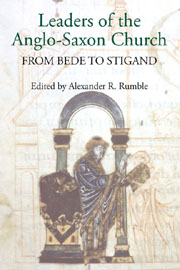Book contents
- Frontmatter
- Contents
- List of Illustrations
- Preface
- Contributors
- Abbreviations
- Introduction: Church Leadership and the Anglo-Saxons
- 1 Bede and the Early English Church
- 2 Archbishop Ecgberht and his Dialogus
- 3 Abbatial Responsibility as Spiritual Labour: Suckling from the Male Breast
- 4 Understanding the Earliest Bishops of Worcester c. 660–860
- 5 The Role of Bishops in Anglo-Saxon Succession Struggles, 955 × 978
- 6 Image-Making: Portraits of Anglo-Saxon Church Leaders
- 7 ‘To Keep Silence Following the Rule's Command’: Bishop Æthelwold, Reforming Ideology and Communication by Signs
- 8 Wulfsige of Sherborne's Reforming Text
- 9 From Winchester to Canterbury: Ælfheah and Stigand – Bishops, Archbishops and Victims
- Index
7 - ‘To Keep Silence Following the Rule's Command’: Bishop Æthelwold, Reforming Ideology and Communication by Signs
Published online by Cambridge University Press: 05 February 2013
- Frontmatter
- Contents
- List of Illustrations
- Preface
- Contributors
- Abbreviations
- Introduction: Church Leadership and the Anglo-Saxons
- 1 Bede and the Early English Church
- 2 Archbishop Ecgberht and his Dialogus
- 3 Abbatial Responsibility as Spiritual Labour: Suckling from the Male Breast
- 4 Understanding the Earliest Bishops of Worcester c. 660–860
- 5 The Role of Bishops in Anglo-Saxon Succession Struggles, 955 × 978
- 6 Image-Making: Portraits of Anglo-Saxon Church Leaders
- 7 ‘To Keep Silence Following the Rule's Command’: Bishop Æthelwold, Reforming Ideology and Communication by Signs
- 8 Wulfsige of Sherborne's Reforming Text
- 9 From Winchester to Canterbury: Ælfheah and Stigand – Bishops, Archbishops and Victims
- Index
Summary
Þis sindon þa tacna þe mon on mynstre healdan sceal þær mon æfter regoles bebode swigan haldan wile and geornlice mid godes fultume begyman sceal.
Early Medieval Monastic Sign Language
THE precise importance of sign language in the Benedictine reform of the tenth century is difficult to assess. However, this aspect of the movement has received so little scholarly attention that it is surely safe to say that its role has been underestimated. The publication of Scott Bruce's Silence and Sign Language in Medieval Monasticism is therefore to be welcomed for placing communication by signs firmly under the gaze of the wider, especially Anglophone, academic public. It is to be hoped that his work will renew analytical interest in the texts among historians and linguists, while prompting a wider debate on the role of signs in reforming life and thought. As a contribution to that debate, this chapter will look at the evidence, exiguous though it may be, for the use of signs in Anglo-Saxon reforming monasteries and will examine the possible role of one of the leading English reformers, Bishop Æthelwold of Winchester, in promoting their use.
The first thing to remark upon is that there is no evidence that manual signs were used as a substitute for speech by monks in England, or indeed on the Continent, before the reform. In England, there is no mention of them in any text earlier than Wulfstan of Winchester's Vita Sancti Æthelwoldi, probably completed c. 996.
- Type
- Chapter
- Information
- Leaders of the Anglo-Saxon ChurchFrom Bede to Stigand, pp. 129 - 146Publisher: Boydell & BrewerPrint publication year: 2012



